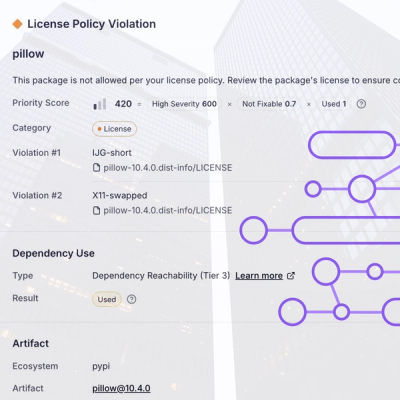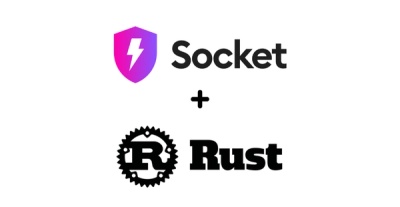
Research
/Security News
Critical Vulnerability in NestJS Devtools: Localhost RCE via Sandbox Escape
A flawed sandbox in @nestjs/devtools-integration lets attackers run code on your machine via CSRF, leading to full Remote Code Execution (RCE).
gatsby-plugin-sharp
Advanced tools
Wrapper of the Sharp image manipulation library for Gatsby plugins
Exposes several image processing functions built on the Sharp image processing library. This is a low-level helper plugin generally used by other Gatsby plugins. You generally shouldn't be using this directly but might find it helpful if doing very custom image processing.
It aims to provide excellent out-of-the box settings for processing common web image formats.
For JPEGs it generates progressive images with a default quality level of 50.
For PNGs it uses pngquant to compress
images. By default it uses a quality setting of [50-75]. The pngCompressionSpeed
value is a speed/quality trade-off from 1 (brute-force) to 10 (fastest). Speed
10 has 5% lower quality, but is 8 times faster than the default (4). In most
cases you should stick with the default, but if you have very large numbers
of PNGs then it can significantly reduce build times.
npm install gatsby-plugin-sharp
module.exports = {
plugins: [
{
resolve: `gatsby-plugin-sharp`,
options: {
// Defaults used for gatsbyImageData and StaticImage
defaults: {},
// Relates to "options.failOn" in https://sharp.pixelplumbing.com/api-constructor#parameters
failOn: `warning`,
},
},
]
}
defaults: Default values used for gatsbyImageData and StaticImage from gatsby-plugin-image.
Available options are: formats,placeholder,quality,breakpoints,backgroundColor,tracedSVGOptions,blurredOptions,jpgOptions,pngOptions,webpOptions,avifOptions.
For details of these, see the reference guide.failOn: default = warning. By default, builds will fail if sharp finds an image with corrupted pixel values. When setting failOn to none the image will return undefined instead. You can customize this option, see options.failOn. Images with corrupt image headers/metadata will always fail, regardless of this setting.width (int, default: 400)height (int)quality (int, default: 50)jpegQuality (int)pngQuality (int)webpQuality (int)jpegProgressive (bool, default: true)pngCompressionLevel (int, default: 9)base64(bool, default: false)src (string)width (int)height (int)aspectRatio (float)Automatically create sizes for different resolutions — we do 1x, 1.5x, and 2x.
width (int, default: 400)height (int)quality (int, default: 50)jpegQuality (int)pngQuality (int)webpQuality (int)base64 (string)aspectRatio (float)width (float)height (float)src (string)srcSet (string)Create fluid sizes (in width) for the image. If the max width of the container for the rendered markdown file is 800px, the sizes would then be: 200px, 400px, 800px, 1200px, 1600px – enough to provide close to the optimal image size for every device size / screen resolution.
If you want more control over which sizes are output you can use the srcSetBreakpoints
parameter. For example, if you want images that are 200, 340, 520, and 890 wide you
can add srcSetBreakpoints: [ 200, 340, 520, 890 ] as a parameter. You will also get
maxWidth as a breakpoint (which is 800 by default), so you will actually get
[ 200, 340, 520, 800, 890 ] as breakpoints.
On top of that, fluid returns everything else (namely aspectRatio and
a base64 image to use as a placeholder) you need to implement the "blur up"
technique popularized by Medium and Facebook (and also available as a Gatsby
plugin for Markdown content as gatsby-remark-images).
When both a maxWidth and maxHeight are provided, sharp will resize the image using
COVER as a fit strategy by default. You can choose between COVER, CONTAIN, FILL,
INSIDE, and OUTSIDE as a fit strategy. See the fit parameter below
for more details.
maxWidth (int, default: 800)maxHeight (int)quality (int, default: 50)jpegQuality (int)pngQuality (int)webpQuality (int)srcSetBreakpoints (array of int, default: [])background (string, default: 'rgba(0,0,0,1)')base64 (string)aspectRatio (float)src (string)srcSet (string)srcSetType (string)sizes (string)originalImg (string)In addition to their individual parameters, all methods above share the following:
grayscale (bool, default: false)duotone (bool|obj, default: false)toFormat (string, default: '')toFormatBase64 (string, default: '')base64Width (int, default: 20)cropFocus (string, default: 'ATTENTION')fit (string, default: 'COVER')pngCompressionSpeed (int, default: 4)rotate (int, default: 0)Convert the source image to one of the following available options: NO_CHANGE,
JPG, PNG, WEBP.
base64 image uses the image format from the source, or the value of toFormat. This setting allows a different image format instead, available options are: JPG, PNG, WEBP.
WEBP allows for a smaller data size, allowing you to reduce your HTML size when transferring over the network, or to use a larger base64 placeholder width default for improved image placeholder quality.
Not all browsers support WEBP. It would be wasteful to include a fallback image format in this case. Consider also adding a backgroundColor placeholder as a fallback instead.
The plugin config option forceBase64Format performs the equivalent functionality by default to all your base64 placeholders. toFormatBase64 has a higher priority for base64 images that need to selectively use a different format.
The width in pixels for your base64 placeholder to use. The height will also be adjusted based on the aspect ratio of the image. Use this to increase the image quality by allowing more pixels to be used at the expense of increasing the file size of the data to be transferred.
The default for Gatsby is 20px. This keeps the data size low enough to embed into the HTML document for immediate display on DOM loaded and avoids an additional network request.
Facebook and Medium are both known to use 42px width for their image placeholders. However Medium presently uses a solid background color placeholder to load the page as fast as possible, followed by an image placeholder requested over the network instead of embedding it with base64.
The plugin config has an equivalent option, allowing you to change the default for all base64 placeholders. This parameter option has a higher priority over the plugin config option.
Change the cropping focus. Available options: CENTER, NORTH, NORTHEAST,
EAST, SOUTHEAST, SOUTH, SOUTHWEST, WEST, NORTHWEST, ENTROPY,
ATTENTION. See Sharp's resize.
Select the fit strategy for sharp to use when resizing images. Available options
are: COVER, CONTAIN, FILL, INSIDE, OUTSIDE. See Sharp's resize.
Note: The fit strategies CONTAIN and FILL will not work when cropFocus is
set to ENTROPY or ATTENTION.
The following image shows the effects of each fit option. You can see that the
INSIDE option results in one dimension being smaller than requested, while
the OUTSIDE option results in one dimension being larger than requested.

Change the speed/quality tradeoff for PNG compression from 1 (brute-force) to 10 (fastest). See pngquant's options.
Rotate the image (after cropping). See Sharp's rotate.
Uses Sharp's grayscale to convert the source image to 8-bit grayscale, 256 shades of gray, e.g.
allImageSharp {
edges {
node {
... on ImageSharp {
resize(width: 150, height: 150, grayscale: true) {
src
}
}
}
}
}
Applys a "duotone" effect (see I, II, III) to the source image if
given two hex colors shadow and highlight defining start and end color of
the duotone gradient, e.g.
fixed(
width: 800,
duotone: {
highlight: "#f00e2e",
shadow: "#192550"
}
) {
src
srcSet
base64
}
the source image colors will be converted to match a gradient color chosen based
on each pixel's relative luminance.
Logic is borrowed from react-duotone.
You can pass a third optional parameter, opacity:
fluid(
width: 800,
duotone: {
highlight: "#f00e2e",
shadow: "#192550",
opacity: 50
}
) {
src
srcSet
base64
}
If set, a semi-transparent version of duotone'd image will be composited over the original image, allowing the original image and its colors to partially "shine through". Heads up: If the original image contains an alpha channel it will be flattened before creating the composite.
This works by adding an alpha channel to the duotone'd image - then we let Sharp
do its magic via
overlayWith;
quoting the Sharp documentation:
If the overlay image contains an alpha channel then composition with premultiplication will occur.
By default, the build will fail when sharp encounters an error while processing an image. You can change parts of this behavior by changing the failOn setting to none. In that case sharp will then ignore any errors relating to the pixel values/file structure of your file. However, if your image has corrupt image headers/metadata the build will still fail. It is important to note that any images that would have otherwise failed will not be accessible via childImageSharp until the underlying issue with the image is addressed.
By default, gatsby-plugin-sharp strips all EXIF, ICC and other metadata
present in your source file. This is the recommended default as it leads to
smaller file sizes.
However, in situations where you wish to preserve EXIF metadata or ICC profiles
(example: you are building a photography portfolio and wish to conserve
the color profile or the copyright information of the photos you've exported
from Adobe Lightroom or Phase One's Capture One), you can set the stripMetadata
plugin option to false in gatsby-config.js.
It is important to note that if stripMetadata is set to false, all
metadata information will be preserved from the source image, including but not
limited to the latitude/longitude information of where the picture was taken
(if present). If you wish to strip this information from the source file, you
can either leave stripMetadata to its default of true, or manually
pre-process your images with a tool such as ExifTool.
This means that there are multiple incompatible versions of the sharp package installed in node_modules. The complete error typically looks like this:
Something went wrong installing the "sharp" module
dlopen(/Users/misiek/dev/gatsby-starter-blog/node_modules/sharp/build/Release/sharp.node, 1): Library not loaded: @rpath/libglib-2.0.dylib
Referenced from: /Users/misiek/dev/gatsby-starter-blog/node_modules/sharp/build/Release/sharp.node
Reason: Incompatible library version: sharp.node requires version 6001.0.0 or later, but libglib-2.0.dylib provides version 5801.0.0
To fix this, you'll need to update all Gatsby plugins in the current project that depend on the sharp package. Here's a list of official plugins that you might need to update in case your projects uses them:
gatsby-plugin-sharpgatsby-plugin-manifestgatsby-remark-images-contentfulgatsby-source-contentfulgatsby-transformer-sharpgatsby-transformer-sqipTo update these packages, run:
npm install gatsby-plugin-sharp gatsby-plugin-manifest gatsby-remark-images-contentful gatsby-source-contentful gatsby-transformer-sharp gatsby-transformer-sqip
If updating these doesn't fix the issue, your project probably uses other plugins from the community that depend on a different version of sharp. Try running npm list sharp or yarn why sharp to see all packages in the current project that use sharp and try updating them as well.
FAQs
Wrapper of the Sharp image manipulation library for Gatsby plugins
The npm package gatsby-plugin-sharp receives a total of 129,933 weekly downloads. As such, gatsby-plugin-sharp popularity was classified as popular.
We found that gatsby-plugin-sharp demonstrated a healthy version release cadence and project activity because the last version was released less than a year ago. It has 7 open source maintainers collaborating on the project.
Did you know?

Socket for GitHub automatically highlights issues in each pull request and monitors the health of all your open source dependencies. Discover the contents of your packages and block harmful activity before you install or update your dependencies.

Research
/Security News
A flawed sandbox in @nestjs/devtools-integration lets attackers run code on your machine via CSRF, leading to full Remote Code Execution (RCE).

Product
Customize license detection with Socket’s new license overlays: gain control, reduce noise, and handle edge cases with precision.

Product
Socket now supports Rust and Cargo, offering package search for all users and experimental SBOM generation for enterprise projects.